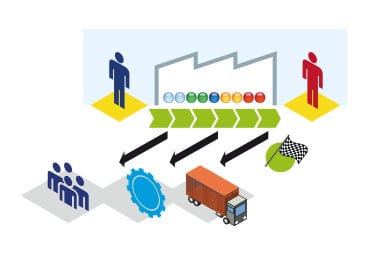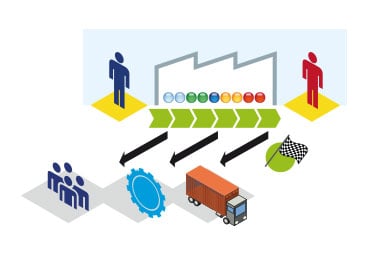Manufacturers: When is There Risk in Taking on a New Customer?
Brian Hoey - June 25, 2019

 Let’s picture a hypothetical. You’re a sales and operations planner at a global manufacturer, specializing in a high-end variety of widget that other global companies tend to order in large quantities. Your sales cycle is fairly long, so every time a member of your sales team closes a deal it feels like a major victory. Recently, you’ve closed one of your largest deals yet, meaning that a large quantity of deliverables need to be produced in the immediate future. This will mean leveraging your production facilities at their maximum capacity for some time (potentially resulting in some wear and tear on your machines that will cause slowdowns later), but, like they say, “make hay while the sun shines.”
Let’s picture a hypothetical. You’re a sales and operations planner at a global manufacturer, specializing in a high-end variety of widget that other global companies tend to order in large quantities. Your sales cycle is fairly long, so every time a member of your sales team closes a deal it feels like a major victory. Recently, you’ve closed one of your largest deals yet, meaning that a large quantity of deliverables need to be produced in the immediate future. This will mean leveraging your production facilities at their maximum capacity for some time (potentially resulting in some wear and tear on your machines that will cause slowdowns later), but, like they say, “make hay while the sun shines.”
Unfortunately, your widgets have some fairly stringent sourcing requirements—and just as you take on this new customer, your suppliers begin to warn you of potential raw material shortages. Soon, you’re in a position where you can’t operate your production facilities at maximum capacity because you simply don’t have enough materials. Without this large order, you might have been able to continue meeting customer expectations through some creative alternatives, but with increased order quantities and material shortages simultaneously, you simply can’t meet demand. You’re faced with the choice of delaying fulfillment on your newest order and almost inevitably losing that client’s future business, or irritating your established customers with late deliveries, resulting in potential lost revenue.
Sales and Operations Planning
We know full well that the example above is a little bit far fetched. At the same time, it works as an illustration of the risks that are always inherent in taking on any new client. That this risk exists certainly isn’t news—it’s just a fact of life for all businesses, manufacturers especially. The real question, from the perspective of a sales and operations planner, is how can you assess the level of risk attached to any particular deal, and what can you do to minimize that risk? After all, no one in their right mind is going to spend an entire blog article trying to convince you not to take on new customers.
Since the purview of sales and operations planning (S&OP) is aligning capacity and demand over the course of monthly or quarterly periods, it makes sense to ask how you can meet customer expectations not just in the short term (i.e. on the level of individual orders), but from a broader organizational perspective. What tactics can you employ in order to ensure that you’re getting everything you need from your suppliers? How can you better align customer orders with the realities of your supply chain? The answers to these questions will help you to better understand—and thus more effectively mitigate—risk when it comes to new business, but actually finding those answers is sometimes easier said than done. What’s a manufacturer to do?
What If?
The questions we posed above aren't the only ones that planners might have to grapple with in order to minimize risk, but let’s take one as a representative example: how can you align your supply chain management with your sales picture? What you really want to know here is this: “what would happen if I made a given hypothetical change to my supply chain functionality?” In order to find that out, you’ll need a certain degree of visibility, i.e. enough to understand what materials in what quantities you're receiving and at what prices/intervals, plus exactly how those materials map onto particular production processes. In this way, you can begin to visualize the trail of cause and effect that impacts your bottom line.
Here, you might want to make use of advanced analytics processes in order to simulate the effects of these potential changes in order to evaluate likely results. Taking on a workflow of this kind requires a high degree of data integration, but the result is that you can use a simulation of your factory to create “What If?” scenarios. By comparing the results of these What If simulations, you could, for example, estimate the potential tradeoffs that would arise if you partnered with a new supplier who offered longer lead times but less chance of a shortage. If it turned out the advanced predictive analytics processes suggested that the longer lead times wouldn’t impede your other supply chain functionality, you might make the tradeoff. If not, you would probably stick with the supplier you currently have and search for other potential sources of risk diversion. Again, this is just an example meant to suggest the ways in which an organization might work within its larger supply chain to mitigate risk—especially risk related to increased demand levels.
Supply Chain Integration
Okay, we’ve shown the ways in which increased demand can increase risk, as well as some of the strategies that might work for reducing that risk. Sounds like we’re done, right? Not exactly. Though the advanced analytics options we discussed above are an important piece of the puzzle, they don’t represent the whole story. To wit, in order to truly gain an understanding of the factors that impact risk levels within your operation, you need to work towards more thorough supply chain visibility. Why? Because that’s your best bet for assessing risks up and downstream in your value chain. By taking in data not just from sources within your own organization but your suppliers and your logistics providers, you can gain an even more thorough accounting of potential hazards and predict the outcomes of future changes with even more certainty.
Like we said above, there’s always some element of risk when you make a change. This includes things like taking on new customers as much as it includes things like updating your IT system or making changes to your supply stream. The goal isn’t to avoid these risks altogether—it’s to understand them well enough that you can face them in a smart, measured way. This way, you capitalize on the risks that are worth taking, and you stay far away from the ones aren’t.
LATEST POSTS
- Understand Why Production Planning Needs Specialized Solutions
- Understand Circular Economy in The Manufacturing Industry
- How Can Industry 4.0 IT Integration Be Achieved Smoothly?
- The Significance of Order Sequencing in Discrete Manufacturing
- How to improve your Supply Chain Management: The Power of Control Towers



